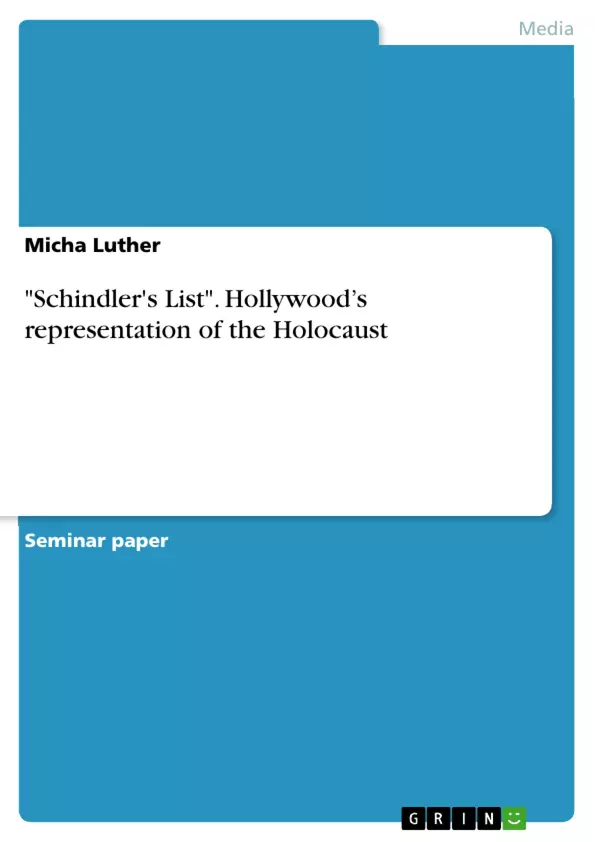"Schindler’s List" is certainly one of the most famous works about the Holocaust that has ever been created so far. Since the 1970s the memory of the Holocaust became more and more integrated as an important element not only of Jewish Amer-ican culture but of American culture in general. The film that was published in 1994 by one of Hollywood’s most famous directors can be seen as a milestone in this process of the “Americanization of the Holocaust”. Other very successful projects preceded that aimed to preserve the memory of the Holocaust in American culture such as the TV series Holocaust or the opening of the National Memorial Museum in 1993.
This process of integrating the Holocaust as an essential part in American culture is described in Peter Novick’s study The Holocaust in American Life. I will try to analyze the film as part of this process and raise several questions about its meaning in this context. I will at first examine the historical background of the time when the film was published. I will try to find out what makes Schindler’s List typical for an American Hollywood movie and how the film “Americanizes” in this way the subject of the Holocaust. Before that I will examine how the idea of Schindler’s List emerged and how it became possible that this delicate topic was chosen by Spielberg who was rather known for his spectacular entertainment movies up to this point. To answer these questions I will also analyze elementary elements of the film: suspense structure, characters, technical aspects and also shortly deal with the reception and critics of the movie. Finally I will discuss the question which impact the movie had or could have for the viewer’s perception of the Holocaust and in which way the movie shaped what Novick calls the “collective memory” of the Holocaust.
Inhaltsverzeichnis (Table of Contents)
- I. Introduction
- II. The historical background: How the idea of Schindler's List emerged.
- II.1. The perception of the Holocaust in American society during the 20th century
- II.2. The Holocaust mini-series as a precursor of Schindler's List
- II.3. Previous initiatives to film Schindler's List
- II.4. How Steven Spielberg came to Schindler's List and the production of the film
- III: Schindler's List - A typical American Hollywood movie?
- III.1. Spielberg's "Americanization of the Holocaust"
- III.2. Story, film structure and suspense.
- III.3. Authenticity.
- III.4.Characters
- III. 6. Summary: Schindler's List – a typical Hollywood movie?
- IV. The Controversy: Critical views on Schindler's List..
- V. Conclusion
Zielsetzung und Themenschwerpunkte (Objectives and Key Themes)
This study aims to analyze the film Schindler's List as part of the process of "Americanization of the Holocaust," examining the historical context surrounding its production and release, and exploring its significance within American culture. The study raises questions about the film's representation of the Holocaust and its impact on viewers' perception of the event.
- The historical context of the Holocaust's integration into American culture
- The influence of preceding film and media representations of the Holocaust
- The film's characteristics as a typical American Hollywood movie
- The film's reception and critical analysis
- The potential impact of the film on the "collective memory" of the Holocaust
Zusammenfassung der Kapitel (Chapter Summaries)
The introductory chapter establishes the significance of Schindler's List as a prominent representation of the Holocaust and outlines the study's approach to analyzing the film's place in American cultural memory. The second chapter explores the historical context of the Holocaust's integration into American society, beginning with the initial postwar perceptions and tracing the evolving understanding of the event through the 1960s and 1970s. This chapter delves into the role of the 1978 miniseries Holocaust in raising awareness of the Holocaust and its impact on public discourse. It also examines earlier attempts to produce a film about Oskar Schindler and the factors that led Steven Spielberg to ultimately take on the project.
Schlüsselwörter (Keywords)
The study focuses on the "Americanization of the Holocaust," the representation of the Holocaust in film, Steven Spielberg's Schindler's List, the reception and critique of the film, and the impact of the film on public memory.
- Citar trabajo
- Micha Luther (Autor), 2013, "Schindler's List". Hollywood’s representation of the Holocaust, Múnich, GRIN Verlag, https://www.grin.com/document/283189



